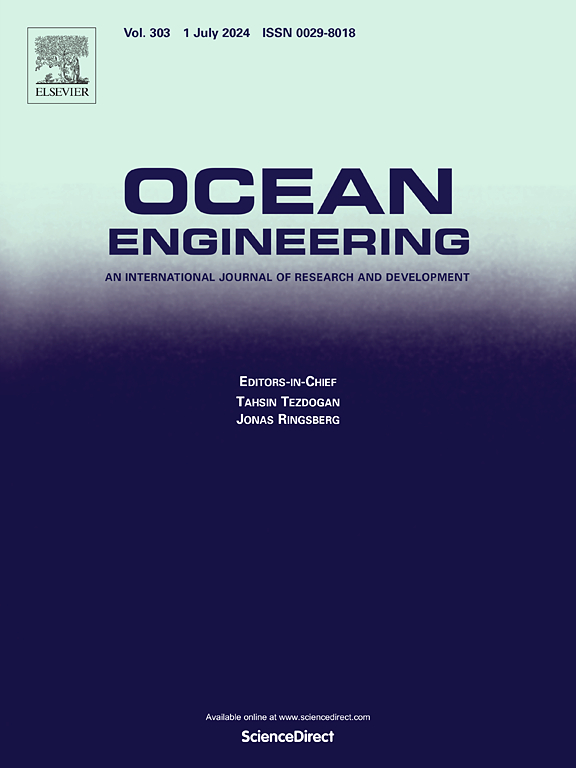Time-domain simulation of nonlinear motions of moored floating body in irregular waves using rankine source method
IF 4.6
2区 工程技术
Q1 ENGINEERING, CIVIL
引用次数: 0
Abstract
This study introduces a three-dimensional time-domain Indirect Boundary Integral Equation Method (IBIEM) for simulating the motion of the floating body in both regular and irregular waves. The method systematically addresses second-order wave loads, focusing on low-frequency motions induced by low-frequency wave loads, crucial for the stability of offshore structures. Unlike traditional methods, the time-domain IBIEM simplifies the analysis by simultaneously considering all wave components of irregular waves, making the calculation of nonlinear wave loads more straightforward and intuitive. An approximate second-order equation of motion is proposed, simplifying the computational process by eliminating the need for solving boundary value problems for second-order radiation forces. The IBIEM is coupled with a quasi-static mooring model based on the elastic catenary equation, accurately capturing the influence of mooring systems on the response of the floating body. Validation against model tests and established numerical methods demonstrates the accuracy of the developed code in predicting the dynamic behavior of offshore structures. Applied to various scenarios, including a truncated cylinder, the barge, H2FPSO, and K-Semi, the results show strong agreement with experimental data, confirming the reliability and effectiveness of the method in simulating complex wave-structure interactions, making it a valuable tool for offshore structure design and analysis.
利用秩源法对不规则波浪中系泊浮体的非线性运动进行时域模拟
本研究介绍了一种三维时域间接边界积分方程法(IBIEM),用于模拟浮体在规则和不规则波浪中的运动。该方法系统地处理二阶波浪载荷,重点关注低频波浪载荷引起的低频运动,这对海上结构的稳定性至关重要。与传统方法不同,时域 IBIEM 通过同时考虑不规则波的所有波分量简化了分析,使非线性波载荷的计算更加简单直观。该方法提出了近似二阶运动方程,无需求解二阶辐射力的边界值问题,从而简化了计算过程。IBIEM 与基于弹性导管方程的准静态系泊模型相结合,准确捕捉了系泊系统对浮体响应的影响。通过模型试验和已有数值方法的验证,证明了开发的代码在预测近海结构动态行为方面的准确性。应用于截断圆柱体、驳船、H2FPSO 和 K-Semi 等各种情况下,结果显示与实验数据非常吻合,证实了该方法在模拟复杂波浪与结构相互作用方面的可靠性和有效性,使其成为海上结构设计和分析的重要工具。
本文章由计算机程序翻译,如有差异,请以英文原文为准。
求助全文
约1分钟内获得全文
求助全文
来源期刊

Ocean Engineering
工程技术-工程:大洋
CiteScore
7.30
自引率
34.00%
发文量
2379
审稿时长
8.1 months
期刊介绍:
Ocean Engineering provides a medium for the publication of original research and development work in the field of ocean engineering. Ocean Engineering seeks papers in the following topics.
 求助内容:
求助内容: 应助结果提醒方式:
应助结果提醒方式:


